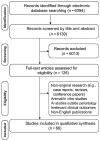Clinical Applications of Artificial Intelligence in Periodontology: A Scoping Review
- PMID: 40572754
- PMCID: PMC12195203
- DOI: 10.3390/medicina61061066
Clinical Applications of Artificial Intelligence in Periodontology: A Scoping Review
Abstract
Background and Objectives: This scoping review aimed to identify and synthesize current evidence on the clinical applications of artificial intelligence (AI) in periodontology, focusing on its potential to improve diagnosis, treatment planning, and patient care. Materials and Methods: A comprehensive literature search was conducted using electronic databases including PubMed-MEDLINE, Cochrane Central Register of Controlled Trials, Cochrane Database of Systematic Reviews, Scopus, and Web of Science™ Core Collection. Studies were included if they met predefined PICO criteria relating to AI applications in periodontology. Due to the heterogeneity of study designs, imaging modalities, and outcome measures, a scoping review approach was employed rather than a systematic review. Results: A total of 6394 articles were initially identified and screened. The review revealed a significant interest in utilizing AI, particularly convolutional neural networks (CNNs), for various periodontal applications. Studies demonstrated the potential of AI models to accurately detect and classify alveolar bone loss, intrabony defects, furcation involvements, gingivitis, dental biofilm, and calculus from dental radiographs and intraoral images. AI systems often achieved diagnostic accuracy, sensitivity, and specificity comparable to or exceeding that of dental professionals. Various CNN architectures and methodologies, including ensemble models and task-specific designs, showed promise in enhancing periodontal disease assessment and management. Conclusions: AI, especially deep learning techniques, holds considerable potential to revolutionize periodontology by improving the accuracy and efficiency of diagnostic and treatment planning processes. While challenges remain, including the need for further research with larger and more diverse datasets, the reviewed evidence supports the integration of AI technologies into dental practice to aid clinicians and ultimately improve patient outcomes.
Keywords: artificial intelligence; dental imaging; diagnosis; periodontology; treatment planning.
Conflict of interest statement
The authors declare no conflicts of interest.
Figures
Similar articles
-
Artificial intelligence for detecting keratoconus.Cochrane Database Syst Rev. 2023 Nov 15;11(11):CD014911. doi: 10.1002/14651858.CD014911.pub2. Cochrane Database Syst Rev. 2023. PMID: 37965960 Free PMC article.
-
Advancements in Herpes Zoster Diagnosis, Treatment, and Management: Systematic Review of Artificial Intelligence Applications.J Med Internet Res. 2025 Jun 30;27:e71970. doi: 10.2196/71970. J Med Internet Res. 2025. PMID: 40587773 Free PMC article. Review.
-
A deep learning approach to direct immunofluorescence pattern recognition in autoimmune bullous diseases.Br J Dermatol. 2024 Jul 16;191(2):261-266. doi: 10.1093/bjd/ljae142. Br J Dermatol. 2024. PMID: 38581445
-
Artificial intelligence models for diagnosing gingivitis and periodontal disease: A systematic review.J Prosthet Dent. 2023 Dec;130(6):816-824. doi: 10.1016/j.prosdent.2022.01.026. Epub 2022 Mar 14. J Prosthet Dent. 2023. PMID: 35300850
-
Artificial intelligence systems in dental shade-matching: A systematic review.J Prosthodont. 2024 Jul;33(6):519-532. doi: 10.1111/jopr.13805. Epub 2023 Dec 6. J Prosthodont. 2024. PMID: 37986239
References
-
- WHO . Global Status Report on Alcohol and Health 2018. World Health Organization; Roma, Italy: 2019.
Publication types
MeSH terms
LinkOut - more resources
Full Text Sources
Miscellaneous




